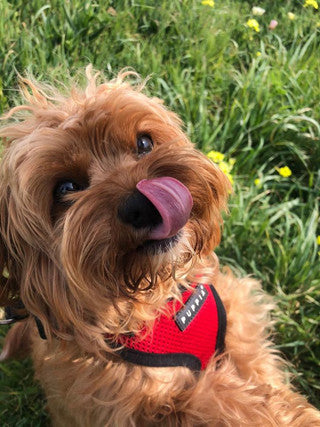If you follow our blog regularly, you probably already know the importance of brushing your teeth and maintaining proper oral hygiene. Most people understand that proper dental hygiene is important for a number of reasons. Brushing at least twice a day helps prevent dental decay and gum disease, both of which can cause considerable pain and discomfort. Tooth decay and gum disease have also been linked to an increased risk of serious health problems like heart disease and diabetes. Unfortunately, what many people don’t realize, is that brushing is important for our pet’s teeth and overall health as well.
Without regular brushing, your pet can experience significant dental problems. In addition to dental decay and bad breath caused by plaque buildup, dogs can develop gum disease and life-threatening infections.
Gum Disease Affects Both Dogs & Cats
Gum disease is an extremely common problem for both dogs and cats. In fact, 75-85% of all dogs and cats have some degree of periodontal disease by the time they reach just three years old. Without proper treatment, gum disease can damage the tissue and bone responsible for holding the teeth in place. When this occurs, the teeth become loose and eventually fall out, making it difficult for your pet to eat. This can lead to serious problems especially for older cats.
When animals don’t eat, their body relies on fat reserves for energy. Before use, this fat is processed by the liver. Cats use up protein reserves much faster than dogs. Once used up, the liver easily becomes overwhelmed by fat. This increases the likelihood of a serious and often fatal condition known as hepatic lipidosis.
Maintaining Good Oral Health in Pets
Maintaining your pet’s oral health doesn’t have to be difficult. With a little time and patience you can learn what works and what doesn’t, and your pet can learn to tolerate having its teeth cleaned daily. Although it’s best to start while your pet is young, good oral hygiene is important at every age.
The type of products used to clean your pet’s teeth can make a big difference in the overall success of your pet’s dental plan. Although some pets will tolerate a traditional style pet toothbrush, many others become frightened by the large size and unfamiliarity of it. Using your finger or a glove-style pet toothbrush can help your pet feel more comfortable. However, be careful if you think your pet might bite. In these cases, it might be best to consult a veterinarian or professional pet groomer for advice.
Keep in mind that you should never use human toothpaste as it may contain toxic ingredients like Xylitol. This artificial sweetener can cause dangerous blood sugar drops as well as liver damage in pets.
Although pet toothpastes exist, they aren’t always efficient at removing plaque and bacteria from the teeth. This can create problems when plaque travels above the gumline increasing the chance of infection and gum disease. It’s important that pet parents take the time necessary to locate a pet-safe toothpaste alternative that thoroughly removes all plaque build-up on the teeth.
LIVFRESH Dental Gel provides an effective alternative to traditional toothpaste. In addition to helping people maintain excellent oral health, this powerful dental gel helps pets avoid painful infections, dental decay, and gum disease. LIVFRESH also helps keep your pet’s breath fresh.
Unlike other toothpastes which can have a strange taste to pets, many people find that their pet enjoys the mild taste of LIVFRESH Non-Foaming and LIVFREE dental gel. In addition to tasting great, studies have shown that LIVFRESH removes plaque 250% better than a leading toothpaste brand, making it an excellent choice for people that care about the health and well-being of their pets.
Brushing Your Pet’s Teeth
It’s important to start with a tiny bit of gel on your finger to see how your pet reacts. Once they become accustomed to the smell and taste of the gel, try adding a little to a pet toothbrush and moving it gently around your pet’s mouth. This will become easier as you and your pet get used to the routine.
If possible, brush your pet’s teeth at least once a day. Make sure you pay attention to the areas around the gum line and look for any signs of tooth decay or swelling of the gums. Take your pet for professional dental cleanings at least once or twice a year as recommended by your veterinarian. You might need to schedule these visits more frequently if your pet has signs of periodontal disease or other dental problems.
Proper oral hygiene helps keep your pet healthy and safe. With the right tools and a little practice, pet parents can learn to properly care for their pet’s teeth.
Please contact LIVFRESH for more information about our quality dental gel.

